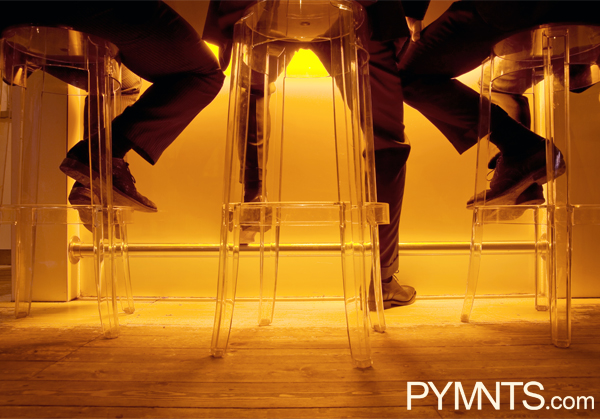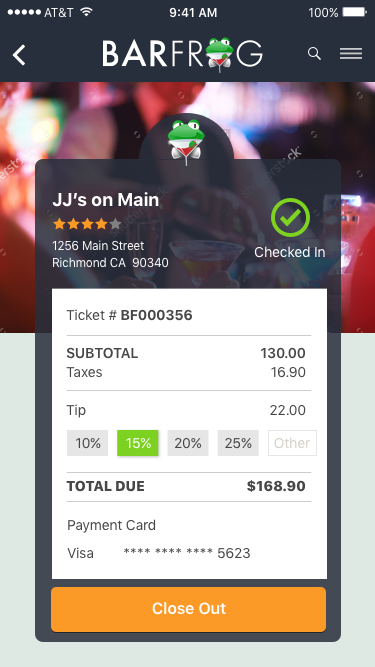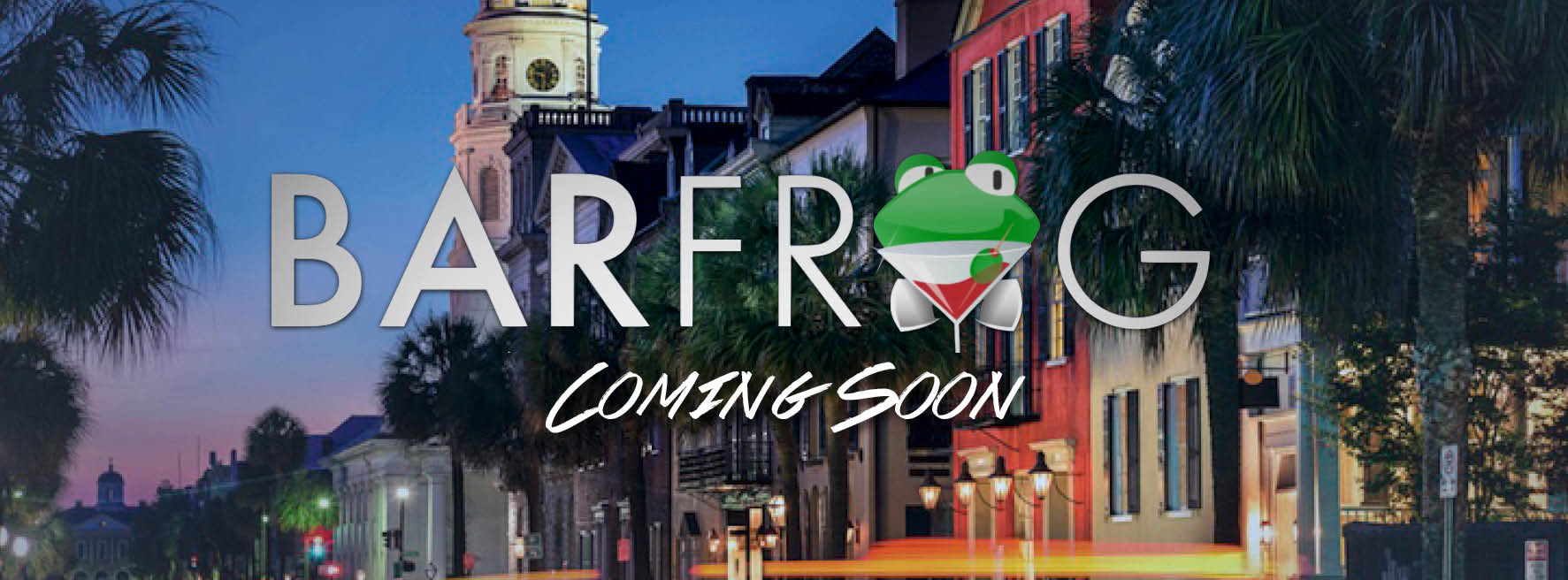Belly Up To The BarFrog

It’s a situation that is all too familiar to most people who have gone out for dinner or even to grab drinks at happy hour.
You’re ready to go, but the waiter or bartender isn’t bringing the bill.
Though restaurants and bars have come a long way in their offerings, oftentimes payments still remain a bottleneck in getting guests in and out the door.
BarFrog is a mobile platform that connects restaurants and bars to the customers who want to frequent them, but with the integration of mobile payments to help maximize the guest experience by allowing them to receive and pay their checks faster. Anthony Milici, the startup’s CEO and co-founder, explained that the inspiration behind the concept actually came from addressing some major frictions faced by himself and his fellow co-founders from their experiences working in hospitality and as customers themselves.
Milici noted that hearing Tony Fadell, one of the visionaries behind Apple’s iPod and iPhone, speak at this year’s Innovation Project really stuck with him, because Fadell explained that when starting a business, there’s 50 percent emotion and 50 percent logical/rational drive toward translating an idea into a functional, operational business.

BARFROG/FACEBOOK
In the case of BarFrog, Milici said the emotional pain points spawned from personal experiences of leaving a payment card at the bar. He noted that for millennials, who use mostly debit cards that are tied directly to their bank accounts, turning over that card to a bartender isn’t easy. Especially when it doesn’t feel or look very safe where cards are stored behind the bar.
“From me being a restaurant guy and my partners being in the industry for so long as well, we all saw how elevated the food and beverage game got — but where was the technology? Why were people still having to close out their bills in such an archaic way?”
“It just didn’t seem or feel right the way things were,” he added.
On the flip side, because of the often long wait times associated with a customer closing their tab, restaurants were often losing out on revenue per available seats per hour. With the elevation in time it takes to make a drink or put out a meal, the result of that is more people actually waiting for their bill, Milici explained.
The idea for BarFrog was born out of a desire to increase the revenue restaurants are maxing off of the seats in their establishments while also improving the overall experience for the customers trying to pay and leave when they want.
In the latest episode of The Matchmaker Is In, Milici joined host Karen Webster to discuss how the Charleston, South Carolina-based mobile app is seeking to accommodate these pain points for both restaurants and users, while also eventually changing the payment behavior in these establishments on a greater scale.
Here is an excerpt of their conversation:
KW: You’ve got the consumer on one side and the restaurant/bar on the other side. How did you make the decision about where to start onboarding? Was it on the restaurant/bar side or on the consumer side? And why?
AM: That’s something we took an in-depth look at when we decided to start our initial marketing push and telling the market about BarFrog, both on the bar side and consumer side. The fact of the matter is, onboarding the customers was the most important. No bar or restaurant is going to hear your sales pitch or hear a product out if you can’t tell them about your following and reach. Yes, they love to hear the vision of what BarFrog can do for businesses and I think they get that, but if we didn’t have the initial foundation of people waiting for the app and wanting to use it, then it would be really tough to onboard the restaurants. For us, we were very fortunate to have gone to college in Charleston (three out of the four partners), where we have a massive network both within the local hospitality industry and also with the students and young professionals. We started angling our marketing efforts towards those markets to really start getting the hype up about BarFrog.
It’s a matter of if the business wants to make their restaurant a “smart” restaurant, because not only are we doing point-of-sale integration and allowing users to pay their bill when they want, but we actually install beacons in these bars and restaurants to allow business owners to control the flow of who is coming in and how they reach their target market.
KW: How long was it between the time you signed up the initial users and when they first got to use the app at a bar?
AM: They had to wait for the actual product launch, and we had to onboard each restaurant individually. Right now, what’s really great about our end users is that they understand that a lot of things are happening in this mobile pay space, and they’ve been expecting something like BarFrog to come along.
Danny Meyer, the CEO of Union Square Hospitality Group and the founder of Shake Shack, recently attended Charleston Food and Wine and asked on a panel why there wasn’t an app that lets guests close out a restaurant tab. He is a titan of industry and set the stage for QSR, so that was a huge insight for us into what these kind[s] of professionals are looking for. Our users are very excited for our product and so are our restaurants. We have 17 restaurants that are locked and loaded, ready to start turning tables faster.
KW: How hard was it to get the first restaurant to say yes? What did they have to do other than trust that the end users who signed up would actually then show up?
AM: The first sale, as you know, is tough. It’s saying, “We have this product (that’s not built yet), but it’s going to be super cool and will do all these things, so here’s our value proposition.” It’s really rough for that first restaurant owner to take that leap of faith, and I think a lot of it has to do with the margins in the restaurant industry, because they are so tight. For us, it was really just a matter of the hard sell. We are very lucky to be in this Charleston market. Due to the fact that it’s so competitive, we work a lot of restaurateurs that are cutting-edge and innovators. They are doing everything they can to make sure their doors remain open, so we’re lucky that these restaurants are on the innovative edge.
BarFrog has a twin-headed value proposition — on one side we can turn tables over faster and use the mobile pay integration for users to control their tabs, and on the other side we have the marketing benefits engine that is the beacons. The beacons pull consumers in by giving them insight as to what specials are running via proximity. Previously, if a restaurant were to run a special, they would put a chalkboard out front with the details. But no one is looking at that anymore, because everyone is on their phones. We look at the beacons as our virtual chalkboard, meaning if you walk past that restaurant and they are a BarFrog-partnered establishment, they can send a notification about their specials right to the user’s phone.
KW: How do the restaurants that you’ve signed on measure the effectiveness of the BarFrog platform? Do they have enough data to know that the proposition of “more turns = more revenue” is working for them?
AM: It’s still too early in the process for them to know, since we are just rolling out our Alpha version. Right now, if we partnered with a restaurant and their sales increased, we would like to take credit for that, but you never know based on the hospitality industry being so seasonal. What we actually provide is hard analytics and data to our clients based on the beacon measuring. For example, based on how many marketing campaigns they decided to send out this week, BarFrog can tell the number of people who received the campaign on their phones, how many engaged with them and ultimately the number that came into the restaurant or bar and made a purchase. What’s really great about us being able to use not only beacons but point-of-sale integration is we not only know who is buying what but who is buying what and where in the restaurant. This is incredibly important if we want to eventually start talking about food distributors and beverage distributors.
KW: For any matchmaker, scale is the oxygen that helps to keep them alive. As you think about your ignition strategy going forward, are you looking to go deep in geographies with the existing capability, or becoming a platform on top of another platform to get scale outside of your geographic focus?
AM: The short answer is a little bit of both. Yes, growth and scale is huge on the user end, and we are already looking at other markets that surround Charleston, like Savannah, Nashville, etc. However, when we’re talking about the matchmaker business, we are going for a concept that lies more in the macro realm; essentially we think people will not be swiping credit cards in five years.
Since we are going for a macro shift in the overall economy, it is really important for us to perfect BarFrog in Charleston. Of course we want to move on to other cities, because that means more revenue for us and growing the business, but the thought process really is that if we are going for this greater shift, then we need to perfect it where we are. Nobody is going to buy into the idea of this being the new revolutionary way to execute restaurant transactions if it’s not perfect in its launch city. To further answer your question, we are also looking at a “powered by BarFrog” platform, because we think that if we can make this [a] mobile solution that works, then why not let other people use it?
KW: How do you make money today? How do you monetize the platform?
AM: We make money in two ways — from the business itself and from the user. BarFrog is a free app; however, if a user would like to close out their tab via BarFrog, they are charged 75 cents. Why we think charging the user is important is because of the ease of use. They could be in a situation, such as their Uber is waiting outside or dealing with a sick friend, where they don’t want to wait for their card; and we see time and time again people either leaving their card behind or leaving their card open and getting charged a 20 percent flat fee on their bill. Our users are okay with paying to bypass that whole process. On the business side, we use a subscription model and there [are] three tiers of service available: One tier is just the payment processing; the next level includes the marketing engine plus payment processing and the third tier you get both plus monthly data reports.
Charging the end users is also important for our business in the sense that there aren’t enough restaurant[s] and bars in the world for us to charge on a subscription model just to grow to where we need to grow. It’s really important to keep the restaurants happy and give them a low cost on their subscription so they can buy into it initially from an early stage. Since we’re in the business of matchmaking, that’s how it needs to work. Both sides have to give a little bit to get the ultimately greater and more efficient product. Our job isn’t to just sell the restaurants or just sell the users on this, it’s really to sell everybody that this is the new way of paying.
KW: In the time we have left, I’d like to get your perspective on matchmakers you admire. I love getting feedback from innovators who take inspiration from their own experiences, but also look at other matchmakers either in their space or adjacent spaces and adapt some of what they have put into play successfully for their own business. Any come to mind for BarFrog and you in particular?
AM: Right off the bat I would say Uber. I know it sounds cliché, but they are the biggest influence out there right now. They’ve done such an incredible job of walking the consumer through this new way of not only paying, but living. This is more than buying a cab; this changes the consumer lifestyle. Instead of having to pull out a card for a cab or call and schedule one, you can do it right on your phone. I’m a huge fan of Uber’s, and we always talk about how what we are trying to do is a very similar process as far as teaching the market a new way to do things.
KW: It’s been about a year since you’ve been in market with this version of BarFrog; if we come back and talk a year from now, what will be different?
AM: Primarily, more users and a product that works perfectly. We are looking at integrating with as many POS systems as we possibly can, and that’s really huge, because we are, in a way, limited to the ones we can work with. We are very lucky that the ones we can work with are the majority of the market, but right now the POS industry is experiencing growing pains. Many of these restaurants are trying to use newer solutions, while the majority is stuck on the antiquated POS hardware and software. In a year from now, I will hopefully be on the phone with you talking about how we brought on 10 new POS companies.

BARFROG/FACEBOOK